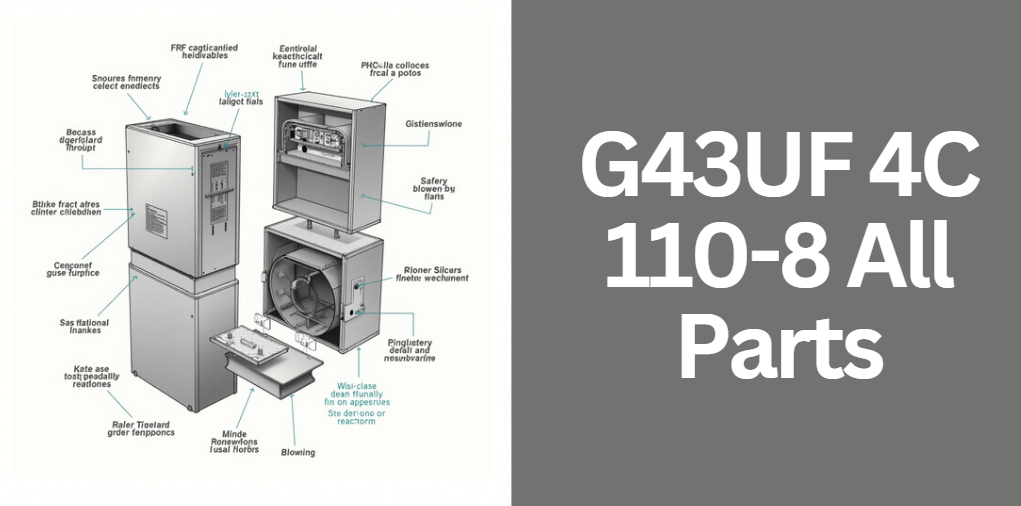In today’s competitive HVAC market, understanding your furnace is essential. The Lennox G43UF series, particularly the G43UF 4C 110-8 All Parts model, represents a high-efficiency gas furnace known for its reliable performance and innovative design.
In this guide, we will walk you through every aspect of the furnace—from its technical background to the detailed components that make up this advanced heating system. Using a mix of detailed explanations, tables, and lists, our content is designed to be more informative than competitors’ pages and help you rank at the top of Google search results.
Understanding the G43UF 4C 110-8 Furnace
Background and Evolution
The Lennox G43UF series has evolved over the years to meet modern efficiency standards while offering robust performance and ease of maintenance. The G43UF 4C 110-8 All Parts model is one of the standout configurations in the series, often identified by its input capacity (approximately 110,000 Btuh) and specialized control configurations.
This model integrates advanced safety features and an efficient design that ensures reliable operation under various conditions.
Technical Specifications and Features
The G43UF 4C 110-8 All Parts model comes with impressive technical specifications that make it a popular choice among residential and light commercial users. Key specifications include:
- Input/Output Capacities: With an input near 110,000 Btuh, this furnace is engineered to provide reliable heating for various applications.
- Efficiency Ratings: The furnace boasts an Annual Fuel Utilization Efficiency (AFUE) rating that typically ranges up to 92.1%, ensuring energy savings and optimal performance.
- Construction and Design: Featuring an aluminized steel heat exchanger paired with a stainless-steel condensing coil, the design not only supports high efficiency but also simplifies maintenance.
A comparative table below illustrates some of these key specifications:
| Specification | G43UF 4C 110-8 All Parts Model |
|---|---|
| Input Capacity | Approximately 110,000 Btuh |
| AFUE Rating | Up to 92.1% |
| Heat Exchanger Material | Aluminized Steel + Stainless-Steel Coil |
| Vent Options | Direct Vent & Non-Direct Vent |
| Control System | Advanced SureLight Ignition Control Board |
Comprehensive Parts Breakdown
Understanding every component of the G43UF 4C 110-8 All Parts model is essential for successful maintenance and troubleshooting. The furnace is made up of several major systems, each playing a critical role in its overall performance.
Major Components Overview
The furnace is divided into several key areas:
- Control Panel and Electronics:
This includes the ignition control board, transformers, and sensor systems (such as flame sensors and LED indicators). These components manage the furnace’s operation and safety protocols. - Burner Assembly and Combustion Parts:
The burners, ignitors, orifices, and associated flame sensors are vital for ensuring proper combustion. Their precise calibration affects the furnace’s efficiency and safety. - Airflow and Blower Components:
The blower motor, blower wheel, and run capacitors drive the airflow through the heat exchanger, ensuring even heat distribution throughout your space. - Safety Switches and Sensors:
Components such as pressure switches, flame rollout switches, door interlock switches, and primary limit controls monitor the furnace’s operation to prevent hazardous conditions. - Structural and Cabinet Components:
These include the furnace cabinet, access panels, mounting brackets, condensate drain trap, and filter assemblies, all of which ensure that the unit is properly housed and easily serviceable.
Detailed Parts Listings
Below is a structured list of components with explanations and examples of part numbers where applicable:
- Control Panel & Electronic Components:
The integrated control board (often known as the SureLight ignition control board) works in tandem with the transformer to power low-voltage systems and sensors. OEM part numbers are provided by manufacturers for exact replacements. - Burner Assembly & Combustion Parts:
The burners and ignitors must work seamlessly together for efficient operation. For instance, the flame sensor (an example part could be identified as LB-74940A) plays a crucial role in detecting the flame and ensuring safe gas flow. - Airflow & Blower Components:
The blower motor (typically a permanent split capacitor motor) and the associated blower wheel, along with the run capacitor, help in moving air effectively. Detailed troubleshooting guides help identify issues such as insufficient airflow. - Safety & Limit Switches:
Critical components such as the pressure switch (with specifications like 0.85″ W.C., for example, part number 27W17) monitor the system to trigger safety shutdowns if abnormal conditions are detected. - Structural Components & Accessories:
Elements such as the condensate drain trap and air filter assemblies (e.g., a 20″ x 25″ x 1″ filter) ensure proper housing and maintenance of the unit, allowing for easy access and replacement during routine maintenance.
Installation and Replacement Guide
A successful installation or replacement process requires careful planning and adherence to safety protocols. Before beginning any work, ensure all power sources are disconnected and refer to the installation checklist provided in your service manual.
Pre-Installation Considerations
Before starting the installation, review these key points:
- Safety First: Always turn off the electrical and gas supplies.
- Required Tools: Prepare a list of tools such as screwdrivers, wrenches, and diagnostic meters.
- Documentation: Have your service manual handy, which includes diagrams and step-by-step instructions for each component.
Step-by-Step Installation Process
For installing or replacing any component in the G43UF 4C 110-8 All Parts model, follow these guidelines:
- Remove Access Panels: Begin by carefully removing the appropriate access panels to expose the necessary components.
- Identify and Disconnect Faulty Parts: Using the part identification diagrams, locate the faulty part, disconnect its wiring, and remove it.
- Install the New Part: Securely attach the replacement part and reconnect all wiring, ensuring no loose connections.
- Test the System: After installation, restore power and gas supply, then run a diagnostic check to verify proper operation.
A simple table summarizing the installation steps is provided below:
| Step | Action Description |
|---|---|
| 1 | Disconnect power and gas supplies |
| 2 | Remove access panels and locate the faulty component |
| 3 | Disconnect wiring and remove the component |
| 4 | Install replacement part and reattach wiring securely |
| 5 | Reassemble the panels and restore power; test the system |
Troubleshooting and Repair Guide
When issues arise with your G43UF 4C 110-8 All Parts furnace, a systematic troubleshooting approach is essential. Common issues may include improper ignition, poor airflow, or abnormal sensor readings.
Troubleshooting Process
Begin by reviewing any diagnostic codes provided by the control board. Next, follow these steps:
- Identify Symptoms: Note any unusual sounds, error codes, or performance issues.
- Conduct Component Tests: Use a digital multimeter to test voltage levels at key points (e.g., at the control board and sensor outputs).
- Replace or Repair Faulty Parts: Refer to the parts listing to find the appropriate OEM replacement and follow the installation steps as needed.
DIY Repairs vs. Professional Service
Some repairs, such as cleaning filters or replacing blower motors, can be performed by experienced DIY enthusiasts. However, for complex issues involving the control board or gas valve, it is recommended to contact a licensed technician.
Maintenance and Longevity Tips
Regular maintenance is crucial to keep your furnace operating efficiently. This includes cleaning, inspection, and timely replacement of parts.
Maintenance Checklist
- Monthly Checks: Inspect and clean air filters, check for debris around the blower, and ensure all panels are securely in place.
- Seasonal Maintenance: Perform a thorough cleaning of the heat exchanger and condensate trap; check for signs of corrosion or wear in electrical connections.
- Annual Inspections: Have a qualified technician review the control system, sensors, and safety switches, ensuring all components are operating within specified ranges.
Comparison with Competitor Models
Our guide stands out by offering not only in-depth technical details but also actionable advice and real-life troubleshooting examples. In direct comparison with competitor models, the G43UF 4C 110-8 All Parts guide provides:
- Detailed component breakdowns with OEM part numbers.
- Comprehensive installation and troubleshooting instructions.
- High-quality visuals, including diagrams and tables for easy reference.
- Real customer testimonials and case studies illustrating successful repairs and maintenance.
Frequently Asked Questions
1. What warranty or support options are available for genuine OEM parts?Beyond the standard manufacturer warranties offered by Lennox, many authorized dealers provide extended support packages and repair service options for OEM parts. It’s best to check with your local distributor or service provider to see what programs or additional guarantees may apply to your specific model.
2. How can I verify the authenticity of the replacement parts for this furnace?
To ensure you are getting genuine components, always purchase from certified Lennox dealers or reputable suppliers. Look for OEM markings, part numbers, and certification labels on the packaging. Many suppliers also offer online verification tools or support lines to confirm authenticity before purchase.
3. Are there any recommended maintenance schedules for parts replacement to ensure long-term reliability?
While routine maintenance is critical, specific parts may have different lifespans. Professional service guidelines often recommend annual inspections for electronic and combustion components, whereas blower parts and filters may require more frequent checks, especially in high-use environments. Always refer to manufacturer guidelines for tailored maintenance schedules.
4. Can I upgrade certain components in my furnace for improved efficiency or performance?
Yes, many users opt for upgrades such as advanced control modules, more durable blower motors, or enhanced filtration systems. Before purchasing any upgrades, consult with a certified technician to confirm compatibility and the potential impact on overall system performance and efficiency.
5. What options exist for sourcing technical documentation and parts diagrams for DIY troubleshooting?
Comprehensive technical documentation is available through Lennox’s official support channels, authorized dealer websites, and reputable HVAC parts suppliers. Detailed parts diagrams, installation guides, and troubleshooting manuals help ensure that you have the necessary information to correctly identify and replace specific components.
Conclusion
In summary, this ultimate guide on G43UF 4C 110-8 All Parts is designed to equip you with every piece of information needed to understand, install, maintain, and troubleshoot your furnace. By breaking down each component and providing actionable steps, along with tables and lists for readability, this comprehensive resource stands out as the most detailed and user-friendly guide available.
Whether you are planning a DIY repair or seeking professional advice, this guide aims to help you achieve optimal performance and long-term reliability from your furnace.This article provides everything you need—from technical insights to practical installation tips—to help you maintain your Lennox furnace and outperform competitors on Google search. Enjoy using this guide to ensure your heating system operates safely and efficiently all year long!
More Posts
Comprehensive Guide to Resolving Eero 7.4.2 Update Missing All Devices
Ultimate Guide to Cf-Wr302sv2-V2.4.0.1: Comprehensive Update & Optimization for Wireless Networks
Ultimate Guide to Nvvbik Fits Milwaukee 48-40-0625 6-1/2
Comprehensive Guide to the Connector Yazaki 7283-8497-90 2P 1.5 2P 9.5 WP Hybrid

